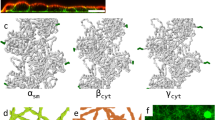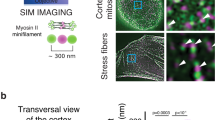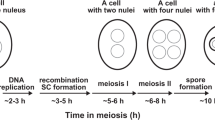Abstract
VERTEBRATE non-muscle cells are known to contain considerable amounts of actin and myosin1–3, but the mechanisms underlying their motility have yet to be elucidated. Various theories have been proposed1,4–7 to explain the well known phenomena of cell migration, membrane ruffling and unidirectional growth processes, different emphasis being placed on the involvement of membrane components and contractile filament assemblies. These hypotheses have been limited, however, by the lack of information about the detailed structural organisation of the motile regions of the cytoplasm. As one approach to this problem we have developed procedures for the direct observation of the filamentous components of the lamella regions of cultured cells in the electron microscope8,9. The method, similar to that adopted by Brown et al.10, consists of the negative-staining of cells grown directly on electron microscope grids after removal of the cell membranes with Triton X-100. By this means, we demonstrate here a single polarity of actin at the leading edge of cultured cells, and consider its implications with regard to cell motility.
This is a preview of subscription content, access via your institution
Access options
Subscribe to this journal
Receive 51 print issues and online access
$199.00 per year
only $3.90 per issue
Buy this article
- Purchase on Springer Link
- Instant access to full article PDF
Prices may be subject to local taxes which are calculated during checkout
Similar content being viewed by others
References
Huxley, H. E. Nature 243, 445–449 (1973).
Pollard, T. D. & Weihing, R. R. CRC Crit. Rev. Biochem. 2, 1–65 (1974).
Tilney, L. G. in Molecules and Cell Movement (eds Inoué, S. & Stephens, R. E.) 339–388 (Raven New York, 1975).
Bray, D. Nature 244, 93–94 (1973).
Harris, A. K. Ciba Fdn Symp. 14, 3–26 (1973).
Abercrombie, M., Heaysman, J. E. M. & Pegrum, S. M. Expl Cell Res. 62, 389–398 (1970).
Wessels, N. K. Ciba Fdn Symp. 14, 52–73 (1973).
Small, J. V. & Celis, J. E. Cytobiologie 16, 308–325 (1978).
Isenberg, G. & Small, J. V. Cytobiologie 16, 326–344 (1978).
Brown, S., Levison, W. & Spudich, J. A. J. Supramolec. Struct. 5, 119–130 (1976).
Albrecht-Buehler, G. & Goldman, R. D. Expl Cell Res. 97, 329–339 (1976).
Small, J. V. J. Cell Sci. 24, 327–349 (1977).
Mooseker, M. S. & Tilney, L. G. J. Cell Biol. 67, 725–743 (1975).
Burgess, D. R. & Schroeder, T. E. J. Cell Biol. 74, 1032–1037 (1977).
Edds, K. T. Expl Cell Res. 108, 452–456 (1977).
Bretscher, M. S. Nature 260, 21–23 (1976).
Woodrum, D. T., Rich, S. A. & Pollard, T. D. J. Cell Biol. 67, 231–237 (1975).
Hayashi, T. & Wallace, I. P. J. Mechanochem. Cell Motility 3, 163–169 (1976).
Author information
Authors and Affiliations
Rights and permissions
About this article
Cite this article
SMALL, J., ISENBERG, G. & CELIS, J. Polarity of actin at the leading edge of cultured cells. Nature 272, 638–639 (1978). https://doi.org/10.1038/272638a0
Received:
Accepted:
Issue Date:
DOI: https://doi.org/10.1038/272638a0
This article is cited by
-
Scrutinising the cytoskeleton
Protoplasma (2023)
-
Optogenetic manipulation of cellular communication using engineered myosin motors
Nature Cell Biology (2021)
-
Stability, Convergence, and Sensitivity Analysis of the FBLM and the Corresponding FEM
Bulletin of Mathematical Biology (2018)
-
Image artifacts in Single Molecule Localization Microscopy: why optimization of sample preparation protocols matters
Scientific Reports (2015)
-
Integration of actin dynamics and cell adhesion by a three-dimensional, mechanosensitive molecular clutch
Nature Cell Biology (2015)
Comments
By submitting a comment you agree to abide by our Terms and Community Guidelines. If you find something abusive or that does not comply with our terms or guidelines please flag it as inappropriate.



